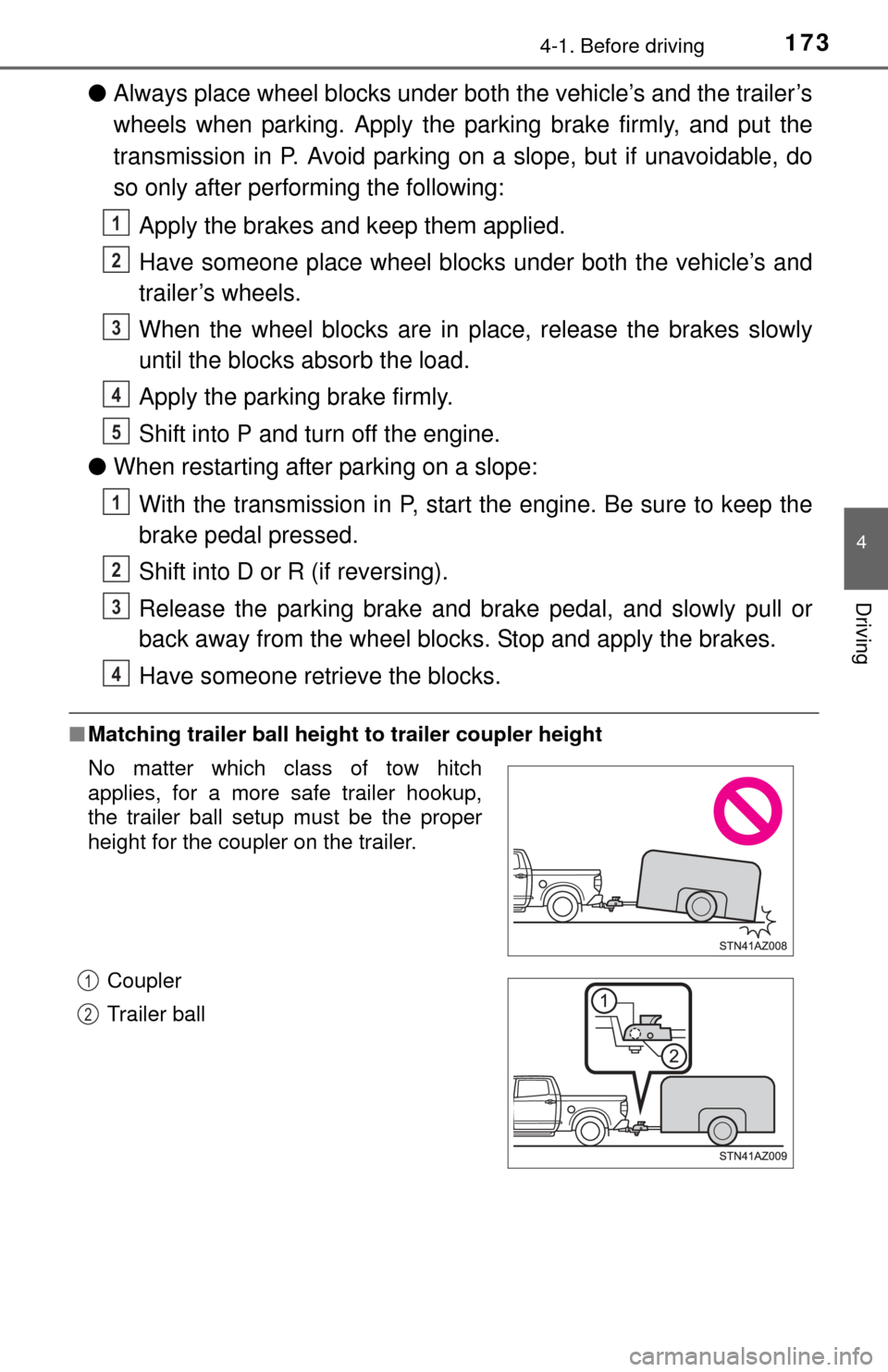Page 163 of 576
1634-1. Before driving
4
Driving
Double Cab models
Model code*1EngineDriving
systemBed typeGCWRTWR
GSK51L-CRASKA 1GR-FE
engine 2WD
Standard 10000 lb.
(4535 kg) 4500 lb.
(2040 kg)
UPK51L-CRTSKA 1UR-FE
engine 12500 lb.
(5670 kg) 6800 lb.
(3080 kg)
UPK56L-CRTSKA 4WD 12500 lb.
(5670 kg) 6500 lb.
(2945 kg)
USK51L-CRTSKA
3UR-FE engine 2WD
Standard 14000 lb.
(6350 kg)
*28200 lb.
(3715 kg)
*2
16000 lb.
(7255 kg)
*310200 lb.
(4625 kg)
*3
USK51L-CRTLKA 14000 lb.
(6350 kg)*28200 lb.
(3715 kg)
*2
16000 lb.
(7255 kg)
*310200 lb.
(4625 kg)
*3
USK52L-CHTSKA Long14000 lb.
(6350 kg)*28100 lb.
(3670 kg)
*2
16000 lb.
(7255 kg)
*310100 lb.
(4580 kg)
*3
USK56L-CRTSKA
4WDStandard 14000 lb.
(6350 kg)*27900 lb.
(3580 kg)
*2
16000 lb.
(7255 kg)
*39900 lb.
(4490 kg)
*3
USK56L-CRTLKA 14000 lb.
(6350 kg)*27900 lb.
(3580 kg)
*2
16000 lb.
(7255 kg)
*39900 lb.
(4490 kg)
*3
USK57L-CHTSKA Long14000 lb.
(6350 kg)*27800 lb.
(3535 kg)
*2
16000 lb.
(7255 kg)
*39800 lb.
(4445 kg)
*3
Page 164 of 576
1644-1. Before driving
*1: The model code is indicated on the Certification Label. (P. 506)
*2: Vehicles without towing package
*3: Vehicles with towing package
USK56L-CRTSGA
3UR-FBE engine 4WDStandard 14000 lb.
(6350 kg)
*27900 lb.
(3580 kg)
*2
16000 lb.
(7255 kg)
*39900 lb.
(4490 kg)
*3
USK56L-CRTLGA 14000 lb.
(6350 kg)*27900 lb.
(3580 kg)
*2
16000 lb.
(7255 kg)
*39900 lb.
(4490 kg)
*3
USK57L-CHTSGA Long14000 lb.
(6350 kg)*27800 lb.
(3535 kg)
*2
16000 lb.
(7255 kg)
*39800 lb.
(4445 kg)
*3
Model code*1EngineDriving
systemBed typeGCWRTWR
Page 165 of 576
1654-1. Before driving
4
Driving
CrewMax models
Model code*1EngineDriving
systemBed typeGCWRTWR
UPK51L-PSTSKA 1UR-FE
engine 2WD
Short 12500 lb.
(5670 kg) 6600 lb.
(2990 kg)
UPK56L-PSTSKA 4WD 12500 lb.
(5670 kg) 6300 lb.
(2855 kg)
USK51L-PSTSKA
3UR-FE engine 2WD
14000 lb.
(6350 kg)
*28100 lb.
(3670 kg)
*2
16000 lb.
(7255 kg)
*310100 lb.
(4580 kg)
*3
USK51L-PSTLKA 14000 lb.
(6350 kg)*28000 lb.
(3625 kg)
*2
16000 lb.
(7255 kg)
*310000 lb.
(4535 kg)
*3
USK51L-PSTZKA 14000 lb.
(6350 kg)*28000 lb.
(3625 kg)
*2
16000 lb.
(7255 kg)
*310000 lb.
(4535 kg)
*3
USK56L-PSTSKA
4WD14000 lb.
(6350 kg)*27800 lb.
(3535 kg)
*2
16000 lb.
(7255 kg)
*39800 lb.
(4445 kg)
*3
USK56L-PSTLKA 14000 lb.
(6350 kg)*27700 lb.
(3490 kg)
*2
15900 lb.
(7210 kg)
*39600 lb.
(4350 kg)
*3
USK56L-PSTZKA 14000 lb.
(6350 kg)*27700 lb.
(3490 kg)
*2
15800 lb.
(7165 kg)
*39500 lb.
(4305 kg)
*3
Page 166 of 576
1664-1. Before driving
*1: The model code is indicated on the Certification Label. (P. 506)
*2: Vehicles without towing package
*3: Vehicles with towing package
■
Unbraked TWR*4
1000 lb. (453 kg)
USK56L-PSTSGA
3UR-FBE engine 4WD Short 14000 lb.
(6350 kg)*27800 lb.
(3535 kg)
*2
16000 lb.
(7255 kg)
*39800 lb.
(4445 kg)
*3
USK56L-PSTLGA 14000 lb.
(6350 kg)*27700 lb.
(3490 kg)
*2
15900 lb.
(7210 kg)
*39600 lb.
(4350 kg)
*3
USK56L-PSTZGA 14000 lb.
(6350 kg)*27700 lb.
(3490 kg)
*2
15800 lb.
(7165 kg)
*39500 lb.
(4305 kg)
*3
*4: These models meet the tow-vehicle trailering requirement of SAE
International per SAE J2807.
Model code*1EngineDriving
systemBed typeGCWRTWR
Page 172 of 576

1724-1. Before driving
●Avoid sudden braking as you may skid, resulting in the trailer jack-
knifing and a loss of vehicle contro l. This is especially true on wet or
slippery surfaces.
● Avoid jerky starts or sudden acceleration.
● Avoid jerky steering and sharp turns, and slow down before making
a turn.
● Note that when making a turn, the trailer wheels will be closer than
the vehicle wheels to the inside of the turn. Compensate by making
a wider than normal turning radius.
● Slow down before making a turn, in crosswinds, on wet or slippery
surfaces, etc.
Increasing vehicle speed can destabilize the trailer.
● Take care when passing other vehicles. Passing requires consider-
able distance. After passing a vehicle, do not forget the length of
your trailer, and be sure you hav e plenty of room before changing
lanes.
● To maintain engine braking effici ency and charging system perfor-
mance when using engine braking, do not use the transmission in
D.
Transmission shift range position must be in 4 in the S mode.
● Instability happens more frequently when descending steep or long
downhill grades. Before descending, slow down and downshift. Do
not make sudden downshifts while descending steep or long down-
hill grades.
● Avoid holding the brake pedal down too long or applying the brakes
too frequently. This could cause th e brakes to overheat and result in
reduced braking efficiency.
● Due to the added load of the trailer, your vehicle’s engine may over-
heat on hot days (at temperatures over 85°F [30°C]) when driving
up a long or steep grade. If t he engine coolant temperature gauge
indicates overheating, immediately turn off the air conditioning (if in
use), pull your vehicle off the road and stop in a safe spot.
( P. 496)
Page 173 of 576

1734-1. Before driving
4
Driving
●Always place wheel blocks under both the vehicle’s and the trailer’s
wheels when parking. Apply the pa rking brake firmly, and put the
transmission in P. Avoid parking on a slope, but if unavoidable, do
so only after performing the following:
Apply the brakes and keep them applied.
Have someone place wheel blocks under both the vehicle’s and
trailer’s wheels.
When the wheel blocks are in pl ace, release the brakes slowly
until the blocks absorb the load.
Apply the parking brake firmly.
Shift into P and turn off the engine.
● When restarting after parking on a slope:
With the transmission in P, start the engine. Be sure to keep the
brake pedal pressed.
Shift into D or R (if reversing).
Release the parking brake and brake pedal, and slowly pull or
back away from the wheel blocks. Stop and apply the brakes.
Have someone retrieve the blocks.
■Matching trailer ball height to trailer coupler height
No matter which class of tow hitch
applies, for a more safe trailer hookup,
the trailer ball setup must be the proper
height for the coupler on the trailer.
Coupler
Trailer ball
1
2
3
4
5
1
2
3
4
1
2
Page 174 of 576

1744-1. Before driving
■Before towing
Check that the following conditions are met:
●Ensure that your vehicle’s tires are properly inflated. ( P. 513)
● Trailer tires are inflated according to the trailer manufacturer’s recommen-
dation.
● All trailer lights work as required by law.
● All lights work each time you connect them.
● The trailer ball is set at the proper height for the coupler on the trailer.
● The trailer is level when it is hitched.
Do not drive if the trailer is not level, and check for improper tongue weight,
overloading, worn suspension, or other possible causes.
● The trailer cargo is securely loaded.
● The rear view mirrors conform to all applicable federal, state/provincial or
local regulations. If they do not, install rear view mirrors appropriate for tow-
ing purposes.
● Depress TOW/HAUL button (if equipped). ( P. 184)
● The manual headlight leveling dial is correctly adjusted. (if equipped)
(P. 190)
■ Break-in schedule
If your vehicle is new or equipped with any new power train components
(such as an engine, transmission, differ ential or wheel bearing), Toyota rec-
ommends that you do not tow a trailer until the vehicle has been driven for
over 500 miles (800 km).
After the vehicle has been driven for over 500 miles (800 km), you can start
towing. However, for the next 500 miles (800 km), drive the vehicle at a speed
of less than 50 mph (80 km/h) when towing a trailer, and avoid full throttle
acceleration.
■ Maintenance
●If you tow a trailer, your vehicle will require more frequent maintenance due
to the additional load. (See “Owner’s Warranty Information Booklet” or
“Scheduled Maintenance Guide”/“Owner’s Manual Supplement”.)
● Retighten the fixing bolts of the towing ball and bracket after approximately
600 miles (1000 km) of trailer towing.
Page 179 of 576
1794-2. Driving procedures
4
Driving
Engine (ignition) switch
Check that the parking brake is set.
Check that the shift lever is set in P.
Firmly depress the brake pedal.
Turn the engine switch to the “START” position to start the engine.
“LOCK”
The steering wheel is locked and
the key can be removed. (The key
can be removed only when the
shift lever is in P.)
“ACC”
Some electrical components such
as the audio system can be used.
“ON”
All electrical components can be used.
“START”
For starting the engine.
■Turning the key from “ACC” to “LOCK”
Shift the shift lever to P.
■ If the engine does not start (vehic les with engine immobilizer system)
The engine immobilizer system may not have been deactivated. ( P. 78)
Contact your Toyota dealer.
Starting the engine
Changing the engine switch positions
1
2
3
4
1
2
Push in the key and turn it to the
“LOCK” position.
3
4
1
2